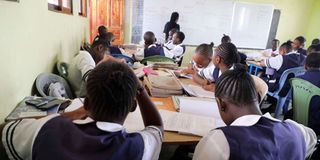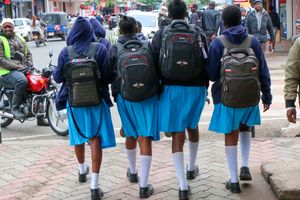
Grade 9 Pupils at Fairfield Primary School, Mombasa, during a lesson in class.
The senior school your child attends and the subjects they choose to study or drop will play a crucial role in shaping their career paths.
Details of the subject combinations required for learners to qualify for various careers are now available on an online platform launched by the Ministry of Education.
The platform is designed to guide learners, their parents as well as teachers in making informed decisions about career pathways.
The 2025 Grade 9 class will be the first to follow the Competency Based Curriculum (CBC) now renamed Competency Based Education (CBE).
The online portal is now open allowing the 1.2 million Grade 9 learners to select their preferred career pathways and the schools they wish to join for Grade 10 (senior school) starting in January 2026.
A total of 9,569 senior schools have been listed on the platform and are categorised into four clusters (C1 to C4), replacing the former categories of national, extra-county, county and sub-county schools.
Under the previous 8-4-4 system, the selection of secondary schools was not linked to learners’ intended careers but was based solely on performance in the Kenya Certificate of Primary Education (KCPE).
In contrast, the new system aligns school selection with career goals, creating expected stiff competition for places in Cluster 1 and 2 schools.
These schools generally have better infrastructure and staffing compared to those in Clusters 3 and 4 which were formerly known as county and sub-county schools and serve the majority of learners.
Career pathway and school selection will be conducted entirely online. The platform links more than 350 professions or careers to specific pathways and outlines the subject clusters learners should study in senior school to qualify for those careers.

Grade 9 learners at Fairfield Primary School in Mombasa during a lesson.
For example, a learner who aspires to become a data analyst should choose the Science, Technology, Engineering and Mathematics (STEM) pathway, select the pure sciences track and then include computer studies in their subject choices.
There are 20 other possible careers associated with studying computer studies.
Placement into senior schools will be automated with the system matching learners based on academic performance, pathway alignment, school capacity and geographic considerations.
“This system is tailored for the CBC framework and focuses on talent, interest and ability – helping students transition smoothly into senior school (Grades 10 to 12),” reads a description on the portal.
Unlike in the past when learners selected schools via a portal run by the Kenya National Examinations Council (Knec), the new system is now operated by the education ministry.
Placement decisions will be influenced by academic performance, learner interests and chosen career pathways. Available school capacity, regional balance and accessibility will also be factors to be considered.
Under CBE, academic performance is assessed through a combination of continuous assessments and national examinations, taken at the end of primary school (Grade 6) and junior school (Grade 9).
Currently, Grade 9 learners are working on their Creative Arts and Sports Project.
They will also sit for the inaugural Kenya Junior Schools Education Assessment (KJSEA) from October 28 to November 3, 2025.
According to senior officials at the ministry, once the results are compiled, the placement process will be automated and final placement outcomes will be sent to both learners and schools.
“The process ensures students are placed in schools that best match their abilities and interests within the CBC framework,” reads an explainer on the website.

A Grade 9 pupil inspects her Integrated Science assessment answer sheet at Fairfield Primary School in Mombasa County.
Basic Education Principal Secretary Julius Bitok said that the ministry will use the Kenya Education Management Information System (Kemis) to admit the 1.2 million Grade 9 learners to senior school.
PS Bitok said the automated selection system has been developed and tested. The piloting and analysis of the pilot results will be completed on June 6, 2025.
Therefore, selection of pathways and subjects combinations by senior schools and Grade 9 learners will be done from June 9 to 30.
Prof Bitok added that heads of senior schools will access the system to select pathways and subject combinations they will be offering.
“The heads of institution (HoIs) of junior schools will access the system to aid learners and parents do the selection. Sub County Directors of Education will access the system to approve the subject combinations selected by senior schools and also monitor junior schools’ selection activities.
Transition from junior to senior school
“County Directors of Education will also monitor progress of the selection and the Head of Senior School Education has the administrator rights to monitor what goes on in the system nationally,” he told Nation last evening.
This new platform will replace the existing National Education Management Information System (Nemis) and is expected to be launched next month.
Kemis is designed to track the performance and mobility of learners and teaching staff from Early Childhood Development Education (ECDE) through to institutions of higher learning, aiming to ensure maximum efficiency and effective use of education resources.
“We will use a new system to ensure that we have a 100 per cent transition from junior school to senior school. We are expecting 1.2 million children to move from JS to SS, and everything is in place to ensure all children secure placements,” he added.
The PS assured the transition to senior school will be smooth and assured that the government will use Kemis to accurately capture and place all Grade 9 learners into Grade 10.
Additional reporting by Winnie Atieno








